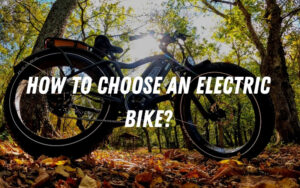Electric bike is just an regular push bike, because it depend on few extra component that work together to operate electric bike with the battery, electric motor, the sensor and the electric display with speed detectors. An electric bike is, is like any other regular pedal bike. When most people hear the term electric bicycle, the first thing that comes to mind is a motorbike or an electric motorbike, but they are not the same thing.
They depend on additional parts that work with each other enabling it to function, such as an electric motor, batteries, a detector, and an LCD mounted display, all of which are smoothly fitted into the design
Table of Contents
What is an Electric bike?
An E-bike is a bike that comes with an inbuilt motor that assists the cyclist in moving the bike. This aid is usually in the shape of handle-assist or pedal-assistance.
A pedal is perhaps the most common alternative, and it works by offering additional controlled electric support as you peddle your bike. While a throttle-control e-bike is more like a motorcycle, it controls the engine and the choice to pedal if desired.
How Does an Electric Bike Work?
At its core, an electric bike operates similarly to a conventional bicycle, with the added boost of an electric motor. The integration of this motor is what sets e-bikes apart and makes them a versatile choice for various terrains and fitness levels. Here's a breakdown of the key components and steps involved in the operation of an electric bike
1. Battery Power
The heart of an electric bike lies in its battery pack. Typically mounted on the frame, the battery powers the electric motor. Lithium-ion batteries are commonly used due to their high energy density, allowing for longer rides between charges. These batteries store electrical energy and supply it to the motor when needed.
2. Electric Motor
Located near the bike's wheels, the electric motor is responsible for providing assistance to the rider. When the rider pedals, sensors detect the motion and activate the motor, which then adds extra power to the pedaling effort. This assistance can be adjusted through different riding modes, such as eco, normal, and high.
3. Controller
The controller acts as the brain of the electric bike, interpreting signals from the sensors and determining the appropriate amount of assistance to provide. It regulates the power output from the battery to the motor, ensuring a smooth and efficient ride.
4. Pedal Sensors
Pedal sensors detect the rider's pedaling cadence and force. These sensors communicate with the controller to initiate the motor assistance. As the rider pedals harder or faster, the motor adjusts its output accordingly, offering a seamless and natural riding experience.
5. Display and User Interface
Modern electric bikes are equipped with user-friendly displays that allow riders to monitor their speed, distance traveled, battery level, and chosen riding mode. The display also provides information about the assistance level and helps riders optimize their riding efficiency.
6. Regenerative Braking
Some electric bikes feature regenerative braking, a technology that converts kinetic energy back into electrical energy during braking. This energy is then fed back into the battery, increasing its efficiency and extending the bike's range.
7. Mechanical Components
Apart from the electronic elements, an electric bike retains the mechanical components of a traditional bicycle, including the frame, wheels, brakes, and gears. These components work in harmony with the electric system to ensure a safe and enjoyable ride.
8. The Detectors
The detector on an E-bike is a critical part. On various e-bikes, one of two types of detectors is used: On various e-bikes, one of two types are:
- a speed detector: When you start pedaling, the speed detector automatically starts the motor, providing you with pedal assist.
- A power detector: The power detector is a little more sophisticated. When you move, it replies with a modest amount of support to meet your speed. It's significantly more responsive and aids in speed and maneuverability.
9. Throttle Assist based
These controllers use a straightforward mechanism. To gain electric help with a throttle, retract or push the throttle. Most electric bikes need nothing more than turning on the throttle to ride without pedaling.
Exploring the Advantages
Now that we've unraveled the inner workings of electric bikes, let's explore the numerous advantages they offer:
1. Eco-Friendly Transportation
Electric bikes produce zero emissions, making them an eco-friendly mode of transportation that reduces air pollution and carbon footprint. They contribute to cleaner air and a healthier environment.
2. Increased Range and Speed
With the assistance of the electric motor, riders can cover longer distances and reach higher speeds with less effort. This makes commuting and exploring hilly terrains a breeze.
3. Health and Fitness Benefits
Contrary to popular belief, electric bikes still require pedaling effort from the rider. This gentle exercise promotes cardiovascular health and strengthens muscles, making them a great option for individuals of all fitness levels.
4. Cost-Effective Commuting
Compared to traditional vehicles, electric bikes offer significant cost savings in terms of fuel and maintenance. Charging the battery is considerably cheaper than purchasing gasoline, and maintenance needs are generally minimal.
5. Reduced Congestion
Electric bikes can maneuver through traffic and congested areas with ease, reducing commute times and frustration. They also contribute to alleviating traffic congestion in urban environments.
6. Customizable Riding Experience
Most electric bikes come with adjustable assistance levels, allowing riders to tailor their experience based on their energy levels and preferences. Whether you want a challenging workout or a leisurely cruise, e-bikes can accommodate your needs
Frequently Asked Questions: ( FAQ )
How does an E-bike get its power?
A battery system powers the electric motor and determines the total range. Most E-bikes employ lithium-ion rechargeable batteries, which vary in size based on the kind of battery and cost of the bike to which they are attached. Most e-bikes feature a single battery pack; however, sure traveling and commuting e-bikes can take two, even three batteries at once. These batteries can be recharged using a regular power adapter.
How fast can an E-bike travel?
E-bikes are restricted in terms of both strength and torque. The motor units have a speed restriction to 25 kph to match the Australian norms, which means that once you reach 25.1 kph, the electric assist will drastically reduce or shut off entirely.
When the help is no longer available, you can keep pedaling the bike by yourself, just like you would a standard bicycle. Similarly, riding downhill is the same as riding a regular bike; you may go as fast as your anxieties let you.
Can I ride an electric bike without pedaling?
Yes, many electric bikes offer a throttle mode that allows you to control the motor without pedaling. However, pedaling is still required for optimal efficiency and range.
How far can I travel on a single battery charge?
The range varies depending on factors like battery capacity, terrain, rider weight, and assistance level. On average, e-bikes can travel 20 to 50 miles per charge.
Are electric bikes legal to use on the road?
Regulations differ by location, but in most places, electric bikes are legal to use on roads, bike lanes, and trails. It's important to check your local laws before riding.
Is it difficult to maintain an electric bike?
Electric bikes require basic maintenance, much like traditional bicycles. Regular tasks include checking tire pressure, lubricating the chain, and keeping the battery charged.
Can I convert my regular bike into an electric bike?
Yes, conversion kits are available to transform your regular bike into an electric one. These kits include a motor, battery, and necessary components for installation.
Are electric bikes suitable for uphill riding?
Absolutely! The electric motor provides extra power, making uphill riding more manageable and less strenuous.
Conclusion
In conclusion, electric bikes have introduced an exciting and efficient way to navigate our world. By seamlessly integrating advanced technology with traditional cycling, these bikes offer numerous benefits for riders of all kinds. As we've discovered, understanding the inner workings of an electric bike helps us appreciate the engineering marvel that brings us effortless and eco-friendly transportation. So, the next time you ask, "How Does an Electric Bike Work?" remember the power of innovation and pedal forth into a greener future.



